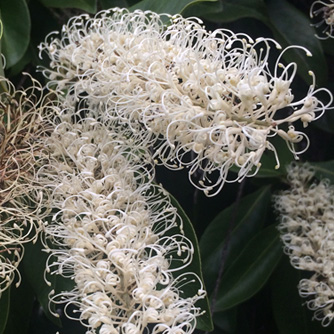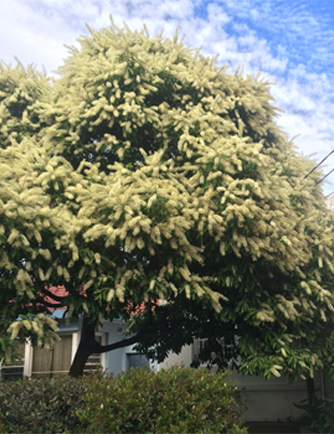Ivory Curl Tree
BackIvory curl trees tick all the boxes as they’re fast growing and easy to care for with spectacular flowers that attract birds. What more could you want? Well they also happen to be an Australian native! Now you’ve just got to get one
Botanically they are called Buckinghamia celsissima but ivory curl tree is just a bit easier on the tongue. This common name perfectly describes their curled ivory coloured flowers which appear from late summer through into autumn. They are produced on the ends of branches and are full of nectar which attracts birds and bees alike.
Ivory curl trees have a lovely dense umbrella shape, with attractive glossy green foliage. New growth often has a pinkish red tinge which provides interest even when not in flower. They are perfect as a feature tree or mass planted for privacy.
How To Grow
Originally from the tropical rainforests of eastern Queensland they are surprisingly adaptable and will even grow in areas with light frosts provided they are in a sheltered position.

Close up of the ivory curl tree flowers
Ivory curl trees can tolerate a wide range of soils but will benefit from good drainage with plenty of organic matter mixed in. The richer the soil the faster the growth. Plant in full sun to part shade and maintain moisture levels until well established. After this they are quite dry tolerant.
Actual tree height will be determined by your climate. In warmer regions they reach 6 to 8 metres (or even higher) but as the temperature drops, so does the height of the tree. This means in places like Sydney or Melbourne the ivory curl tree is more of a large shrub than a real tree.
Plants usually flower after 2-3 years.
Fertilising
To speed the growth of young plants apply OCP eco-seaweed and OCP eco-aminogro every 2-4 weeks during the warmer months. Established trees can be fertilise in spring and autumn with a Certified Organic pelletised fertiliser.
Pruning
Trees usually develop into a nice shape naturally with little pruning required. Pruning can be done to restrict their height if necessary and spent flower heads can be trimmed off if they bother you.
Pests and Diseases of Ivory Curl Trees
Ivory curl trees seldom suffer from pests and diseases but occasionally aphids and mites may attack. Control with a couple of sprays of OCP eco-oil. Scale may also develop and require spraying with a horticultural oil.

Ivory curl tree in full flower


